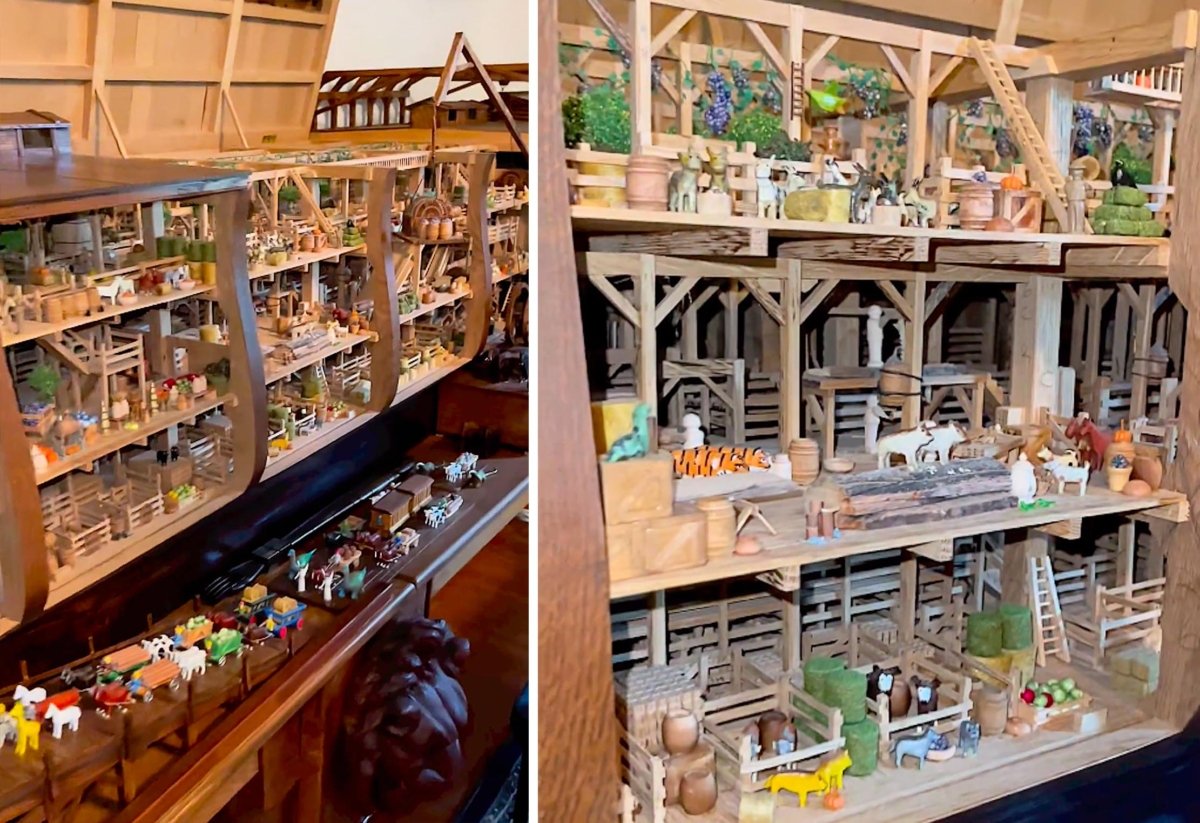A Virginia construction worker has spent years of evenings and weekends building a model of Noah’s Ark, which he has made as perfect as possible, faithfully recreating one of the Bible’s most enduring epics.
Mackie Jenkins, 65, started a Bible study ministry three decades ago in Warrenton, Virginia. In 1999, he began building models of the Noah’s Ark as visual aids to his his Bible teaching.
“We found a log when I was doing hybrid construction, about 45 feet below street level in Alexandria, Virginia, on a high-rise we were building,” Mr. Jenkins told The Epoch Times, adding his belief about its origins. “The log was not from this time period.” Jenkins believes the log was of antediluvian in origin.
The log find prompted Jenkins to build the first of several Ark models that would grow successively larger in scale; he used the log to build a 6-foot (1.8 meter) prototype. This was about the same time that Ken Ham, founder of the “Answers in Genesis” apologetics ministry, was building his massive “Ark Encounter,” full scale model of Noah’s Ark, in northern Kentucky.
Ham’s massive 1 to 1 reconstruction of the Ark inspired Mr. Jenkins to think big. He wanted to incorporate all 15 biblical scenes of the Ark in one model, including its construction, the boarding of animals, and its landing on “the mountains of Ararat” after the flood. His 6-foot model proved too small, so he spent two more years, between 2015 and 2017, building a 12-foot (3.6-meter) version.
This is Jenkins’ second Ark, 12 feet long, showing some very nice wood grain
After he built the 12 footer, he said to himself, “Well, we’re getting close, but we’re still not there.” So he built a third one. Starting around 2019, he drew plans for a larger Ark and gathered wood materials from an Amish sawmill near Lancaster, Pennsylvania. There he found the quarter-sawn oak that would give the ornamental finish he desired. The Amish processed the wood by cutting it “the wrong way” to expose and show off the pattern of the wood grain.
“It would draw [people’s] attention, and then we can tell them about the Ark and the gospel of Jesus Christ,” said Mr. Jenkins, who spent between $4,000 and $5,000 on the beautiful wood alone.
Mackie Jenkins with his second Ark model
For a third time, Mr. Jenkins called upon Virginian furniture restoration expert Jeff Hadley, from Winchester, who helped on the previous two Ark replicas, to design the magnum opus.
“The exact dimensions are given in the Bible: It’s 300 cubits long, by 50 cubits wide, and 30 cubits tall,” Mr. Jenkins said. “That amounts to about 500 feet [152 meters] long, by 85 feet [25 meters] wide, and 65 feet [19 meters] tall.” model measures about 12-and-a-half feet (3.8 meters) long, by 3 feet (one meter) wide, by 2 feet (0.6 meters) tall. That makes it exactly 1:40 in scale.
Jenkins had three goals. (1) to match the proportions as given in the Bible, (2) to design something that would look roughly like the Ark Encounter, and (3) to incorporate a lesson into the model.
Detail of miniatures inside the model
The Ark was said to have been built of gopher wood and covered with pitch, a type of resin from the “kaphar” tree, denoting the Hebrew word for atonement, symbolizing that everyone who entered the ark had his sins atoned for.
Once the plan for the body of the Ark and interior diorama was finished, Mr. Jenkins began hunting for miniature animals. He found a company in Erzgebirge, Germany, that once made miniature wooden Noah’s Ark animals at exactly 1:40 scale. He spent years snapping up these miniature animals on eBay.
Mr. Jenkins was aware of the distinction between clean and unclean animals, the former including lambs, cows, goats, and chickens; the latter including swine, dogs, rats, and snakes, among many others.
“There was a sacrificial system,” Mr. Jenkins said, noting that seven each of the clean animals were brought aboard the Ark. One would be sacrificed to atone for sins, leaving “three complete pairs to reproduce for later sacrifices.” The unclean animals, by contrast, were brought in “two by two.”
Mr. Jenkins discovered that model railroaders often work in the 1:40 scale, and that discovery open up new sources for illustrative miniatures, including tiny hay bales, fruit trees, and food and drink items. He added working LED lights as oil lamps, manual elevators with moving animals, and Bluetooth speakers to play creature sounds for added realism.
Noah himself is depicted in several scenes, including drinking grape juice in the Ark’s galley, an ominous foreshadowing of a post-Flood incident. To show off the whole, Mr. Jenkins made removable panels to reveal a cross-section of the interior.
After years of research, trial runs, and devotion to detail, Mr. Jenkins’s final Ark replica sits proudly in his Bible study office in Warrenton, the same room where he writes his books. It has not yet been on tour as Mr. Jenkins’s second model has. This is frequently driven to schools, churches, and outdoor festivals as a Bible-teaching tool. The touring replica was on display at Ocean City, Maryland.
Mr. Jenkins plans to retire from construction in two years, and enter full-time ministry. Eventually, the model Arks will be handed down to Mackie’s son, who runs a Bible study group, so the models will continue to educate and enlighten future generations.
For they willingly ignore that, by the word of God the heavens existed long ago, and the earth was formed standing out of the water and in the water, by which the world that then existed was flooded with water and perished. 2 Peter 3:5-6 MEV




